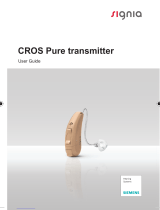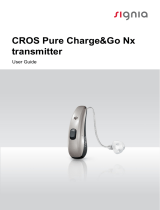Table of Contents
Overview
Push Button Micro RIC 312 Overview . . . . . . . . . . . . . 4
Preparation
Batteries/Battery Indicators . . . . . . . . . . . . . . . . . . . . . 6
Insertion and Removal . . . . . . . . . . . . . . . . . . . . . . . . . 9
Operation
Power On & Off . . . . . . . . . . . . . . . . . . . . . . . . . . . . . 11
User Controls . . . . . . . . . . . . . . . . . . . . . . . . . . . . . . . 11
Volume Control . . . . . . . . . . . . . . . . . . . . . . . . . . . . . 12
Volume Control Indicators . . . . . . . . . . . . . . . . . . . . . 14
Memory Change . . . . . . . . . . . . . . . . . . . . . . . . . . . . 14
Mute . . . . . . . . . . . . . . . . . . . . . . . . . . . . . . . . . . . . . . 15
CROS/BiCROS Balance Control . . . . . . . . . . . . . . . . 15
Multiflex Tinnitus Level Control . . . . . . . . . . . . . . . . . 15
Directional Settings . . . . . . . . . . . . . . . . . . . . . . . . . . 16
Telephone Use . . . . . . . . . . . . . . . . . . . . . . . . . . . . . . 16
CROS/BiCROS Technology . . . . . . . . . . . . . . . . . . . . . . . 19
Multiflex Tinnitus Technology . . . . . . . . . . . . . . . . . . . . . 20
Accessories
Wireless Accessories . . . . . . . . . . . . . . . . . . . . . . . . . 22
Hearing Instrument Care
Instrument Care . . . . . . . . . . . . . . . . . . . . . . . . . . . . . 23
Service and Repair . . . . . . . . . . . . . . . . . . . . . . . . . . . 24
Troubleshooting Guide . . . . . . . . . . . . . . . . . . . . . . . 25
Tips for Better Communication � � � � � � � � � � � � � � � � � � � � � 26
Safety Information � � � � � � � � � � � � � � � � � � � � � � � � � � � � � � � � � � 28
FDA Information � � � � � � � � � � � � � � � � � � � � � � � � � � � � � � � � � � � � 30
FCC Information � � � � � � � � � � � � � � � � � � � � � � � � � � � � � � � � � � � � 35




























